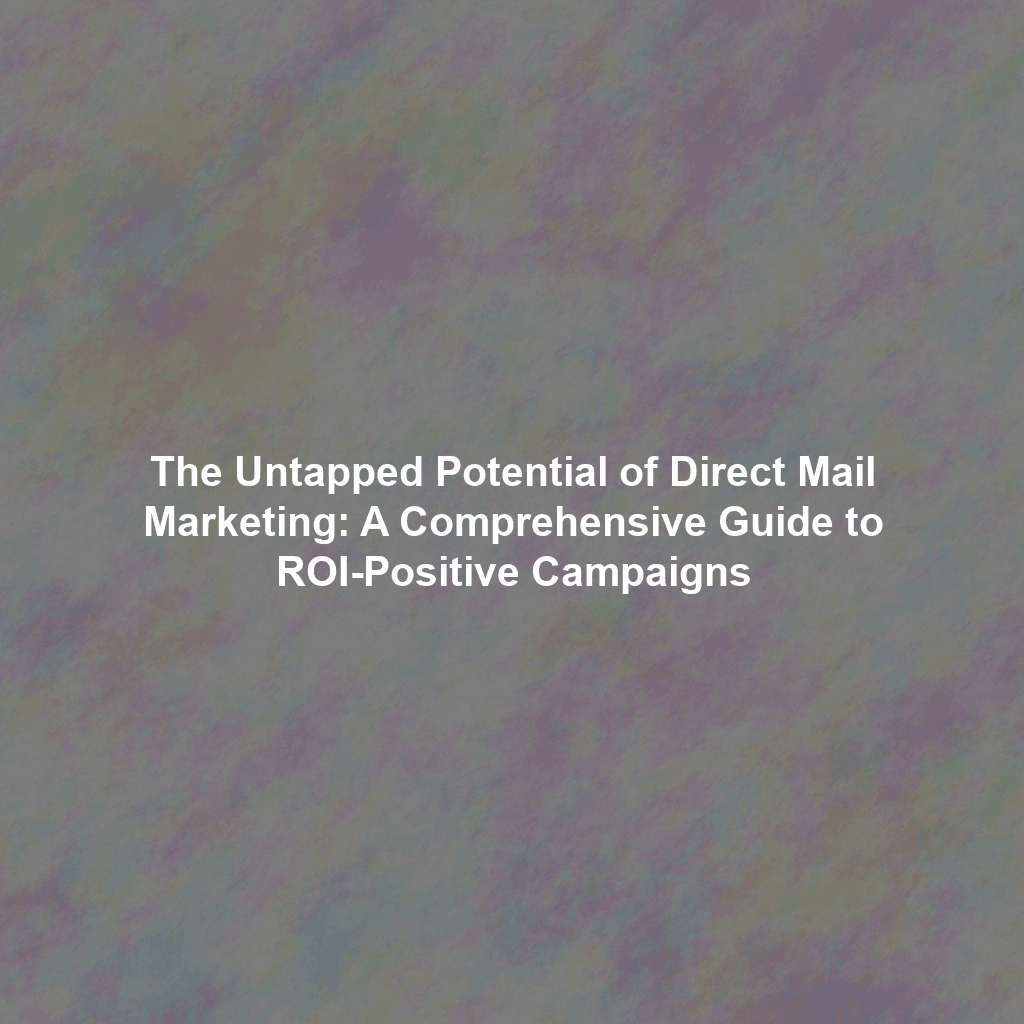In today’s digital-saturated world, it’s easy to overlook the power of tangible marketing. While online strategies dominate headlines, direct mail marketing offers a unique opportunity to connect with your audience in a personal and memorable way. Far from being outdated, direct mail is experiencing a resurgence, delivering impressive ROI for businesses that understand how to leverage its unique strengths. This guide will walk you through creating ROI-positive direct mail campaigns, covering everything from strategy and design to segmentation, personalization, and tracking.
Why Direct Mail Still Matters
Direct mail offers advantages that digital marketing simply can’t replicate. It’s tangible, which means it can create a deeper impression and has a longer lifespan than a fleeting online ad. People often hold onto mail, share it with others, or display it, extending its reach. Furthermore, in a world of overflowing inboxes, a well-designed piece of mail can cut through the digital noise and capture attention.
Benefits of Direct Mail Marketing:
- High Open Rates: Direct mail consistently boasts higher open rates than email.
- Tangible Connection: The tactile experience enhances brand recall.
- Less Competition: Stand out from the digital clutter.
- Targeted Reach: Precise audience segmentation ensures your message reaches the right people.
- Creative Freedom: Unleash your creativity with unique formats and designs.
Crafting Your Direct Mail Strategy
A successful direct mail campaign begins with a well-defined strategy. This involves identifying your target audience, defining your campaign goals, and setting a budget.
Defining Your Goals:
- Lead Generation: Drive traffic to your website or encourage sign-ups.
- Sales Increase: Promote specific products or services and offer exclusive deals.
- Brand Awareness: Reinforce your brand message and build recognition.
- Customer Loyalty: Reward existing customers and encourage repeat purchases.
Identifying Your Target Audience:
Understanding your ideal customer is crucial. Consider factors like demographics, interests, purchasing behavior, and geographic location. This information will inform your segmentation strategy and ensure your message resonates with the right people.
Segmentation and Personalization: The Keys to ROI
Generic mailers are a waste of resources. Effective direct mail relies on segmentation and personalization to create a relevant and engaging experience for each recipient.
Segmentation Strategies:
- Demographic Segmentation: Age, income, education, location.
- Behavioral Segmentation: Past purchases, website activity, engagement with previous campaigns.
- Psychographic Segmentation: Interests, values, lifestyle.
Personalization Techniques:
- Variable Data Printing (VDP): Personalize names, addresses, and even imagery based on individual recipient data.
- Customized Messaging: Tailor your message to address specific needs or interests.
- Relevant Offers: Provide offers that are relevant to the recipient’s past purchases or expressed preferences.
Designing for Impact: Making Your Mailer Stand Out
Your direct mail piece needs to grab attention and convey your message effectively. Consider the following design elements:
Key Design Considerations:
- Eye-Catching Visuals: Use high-quality images and graphics that are relevant to your brand and message.
- Compelling Headline: Capture attention immediately with a clear and concise headline.
- Clear Call to Action: Tell recipients exactly what you want them to do (e.g., visit your website, call a number, redeem a coupon).
- Brand Consistency: Maintain a consistent brand identity across all your marketing materials.
- High-Quality Materials: Use paper stock and printing techniques that reflect the quality of your brand.
Format Matters:
Think beyond the standard letter. Consider postcards, brochures, catalogs, or even dimensional mailers to create a memorable experience.
Tracking and Measuring Your Results
Tracking your direct mail campaign’s performance is essential for optimizing your strategy and maximizing ROI. Here’s how:
Tracking Methods:
- Unique URLs: Use unique URLs that redirect to specific landing pages on your website.
- QR Codes: Integrate QR codes that recipients can scan to access more information or redeem offers.
- Promo Codes: Include unique promo codes that recipients can use online or in-store.
- Call Tracking Numbers: Use unique phone numbers for your direct mail campaign to track inbound calls.
- Matchback Analysis: Compare your mailing list to your sales data to identify customers who responded to your campaign.
Key Metrics to Monitor:
- Response Rate: The percentage of recipients who take the desired action.
- Conversion Rate: The percentage of respondents who become customers.
- Cost Per Acquisition (CPA): The cost of acquiring a new customer through your direct mail campaign.
- Return on Investment (ROI): The overall profitability of your campaign.
Conclusion: Embrace the Power of Direct Mail
Direct mail marketing, when executed strategically, can be a powerful tool for reaching your target audience and driving ROI. By understanding the principles of segmentation, personalization, design, and tracking, you can create campaigns that cut through the digital clutter and deliver tangible results. Don’t underestimate the enduring power of a well-crafted, personalized piece of mail in today’s marketing landscape. It’s a proven method that, when integrated thoughtfully, can significantly boost your marketing efforts.
 Skip to content
Skip to content

